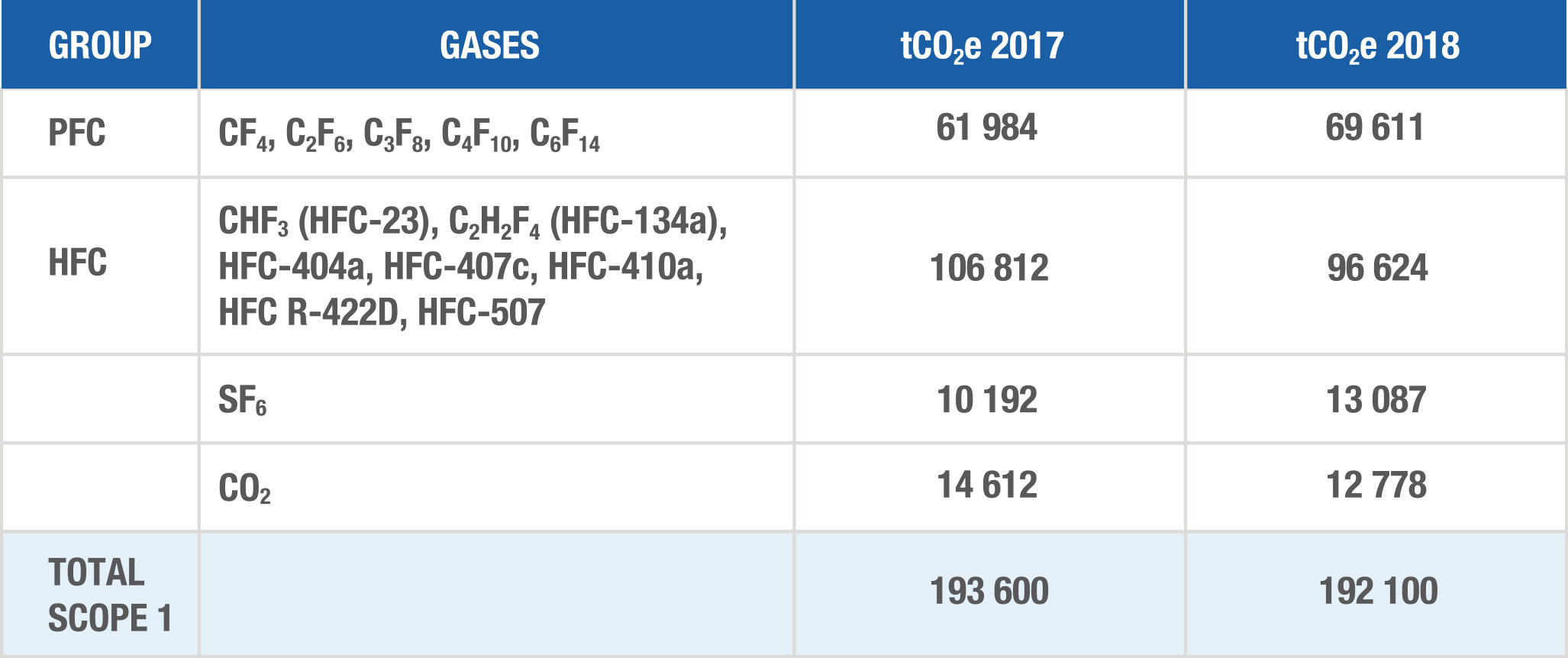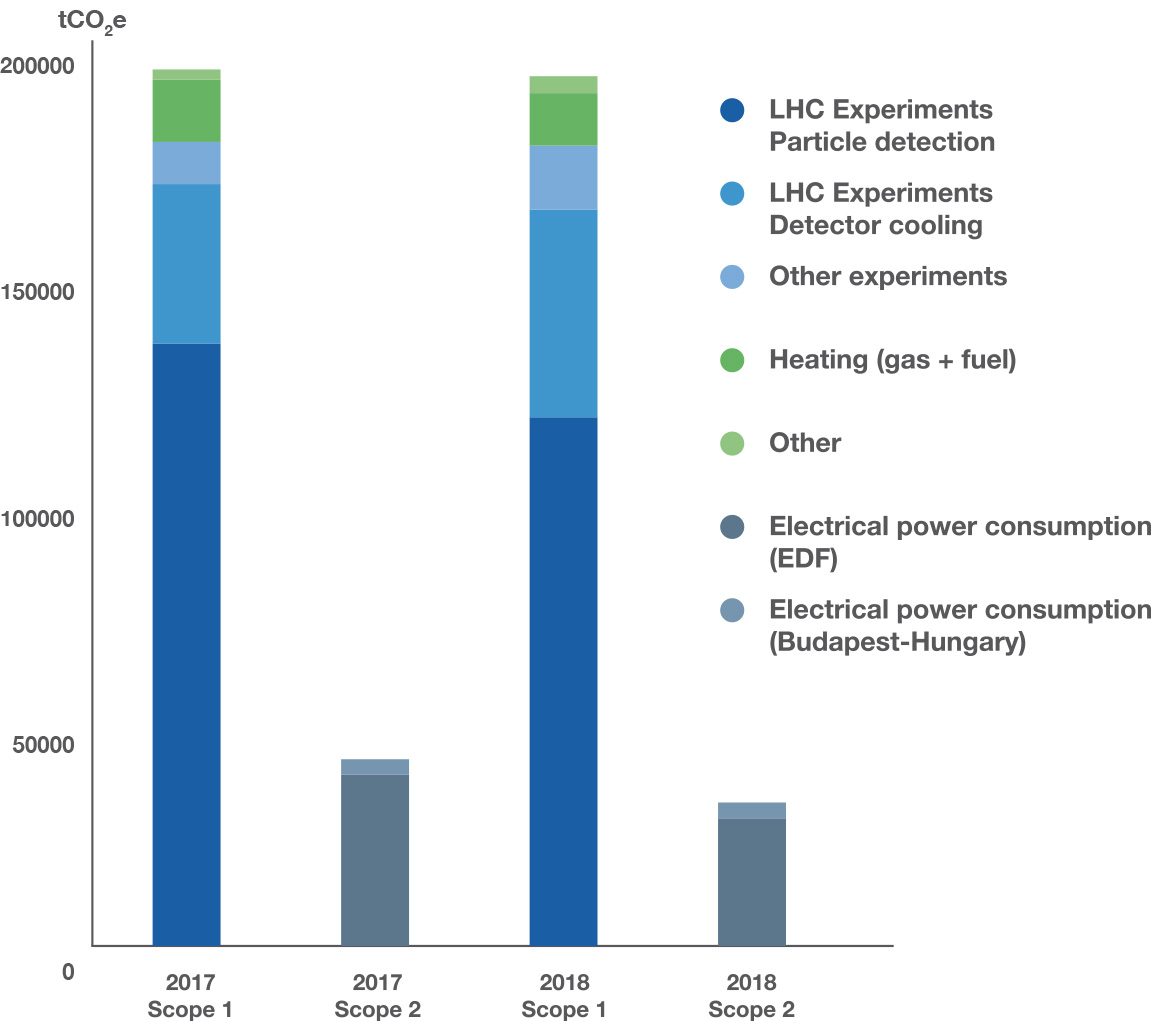 |
|
|
BREAKDOWN OF SCOPE 1 EMISSIONS BY GAS TYPE. Global warming potential, GWP, based on EU Regulation 517/2014 on fluorinated greenhouse gases, while HFC-407c, HFC-410a, HFC-404a, HFC R-422D, and HFC-507 are based on the IPCC Fifth Assessment Report, 2014 (AR5). |
|
 |
|
|
CERN SCOPE 1 AND SCOPE 2 EMISSIONS FOR 2017 AND 2018 BY CATEGORY. Other includes air conditioning, electrical insulation, emergency generators and CERN vehicle fleet fuel consumption. |
Greenhouse gas emissions at CERN arise from the operation of the Laboratory’s research facilities. The majority of emissions come from CERN’s core experiments and more than 78% are fluorinated gases. With climate change a growing concern, the Organization is committed to reducing its direct greenhouse gas emissions.
Direct emissions
CERN’s total amount of scope 1 greenhouse gas emissions, those produced directly by the Organization, was 192 100 tonnes of CO2 equivalent, tCO2e, in 2018, 92% of which is related to the activities of the large LHC experiments. This is due to various fluorinated gases, F-gases, used for particle detection and detector cooling purposes.
CERN and its experiments use SF6, HFCs and PFCs for particle detection, HFCs and PFCs for detector cooling, and HFCs for air conditioning systems. SF6 is also used for electrical insulation in power supply systems.
Detectors installed in the LHC experiments are equipped with F-gas recirculation systems. Because of gas purity requirements, they have a 90% recirculation efficiency. The main contributors to CERN’s F-gas emissions are small leaks in the detectors due to their necessarily light construction. Repairing them is an ongoing priority for the Laboratory.
Indirect emissions
CERN’s total amount of scope 2 greenhouse gas emissions, those due to CERN's electricity consumption, was 31 700 tCO2e in 2018. The source of the emission factors used is EDF Bilans des émissions de GES 2002-2018, which is a location-based approach. This means that the calculations are based on average energy generation emission factors for the local energy grid. The Organization’s principal electricity supplier, EDF, uses low-carbon power, mainly nuclear, which keeps the emissions relatively low. The total indirect emissions also include 3489 tCO2e from the electricity consumed by a CERN-operated data centre at the Wigner Centre in Budapest. The source of the emission factors used is Bilan Carbone® V8.1 2018, which is a location-based approach. From 2020 onwards, CERN will no longer operate computing facilities in Budapest.
Managing emissions at CERN
CERN’s HSE Unit reports annually on greenhouse gases emitted on Swiss territory to Swiss authorities and has done so since 2014. The Organization also reports to French authorities on request. Because of their major contribution F-gases in LHC experiments are the main focus of CERN’s greenhouse gas emissions mitigation effort. The Organization stabilised emissions between the first and second LHC runs by fixing leaks, optimising gas recirculation systems and installing F-gas recuperation systems. Run 1 was from 2009-2013, Run 2 from 2015-2018.
CERN has a formal objective to reduce its scope 1 emissions by 28% by the end of 2024. To achieve this objective, in addition to the ongoing efforts, CERN will replace F-gases in detector cooling systems with CO2, which has a significantly lower global warming potential. Longer-term objectives will be set in future reports.
Mobility management
|
Given CERN’s nature as an intergovernmental organisation hosting worldwide collaborations, mobility is fundamental to its mission. Scope 3 emissions include all other indirect emissions. At CERN these arise mainly from the travel of users, committee delegates and CERN employed personnel. Scope 3 emissions are recognised as an important topic to address. A future report will cover those arising from CERN staff travel, along with mitigating measures.
Around 77% of CERN personnel commute to work from France, most using individual motorised vehicles due in part to a lack of public transport. CERN’s goal until 2025 is to keep individual motorised vehicle commuting constant, despite a growing scientific community. Overall, walking and cycling constitute 17% of all commutes, which is well above the Swiss national average of 6%.
IN FOCUS
Roberto Guida, Beatrice Mandelli and Paolo Petagna work in CERN’s Detector technologies group. Guida is project manager for gas systems, in which Mandelli also works. Petagna is project manager for detector cooling systems.

AN HFC-134A RECUPERATION PLANT INSTALLED AT POINT 5 OF THE LHC. (Image: CERN)
— How is CERN working to reduce the use of greenhouse gases in particle detection?
BM: The refrigerant HFC-134a, used in particle detectors in the LHC experiments, is responsible for half of CERN’s scope 1 emissions. The second long shutdown of the LHC, currently ongoing, will give a unique chance to repair leaks and optimise the gas systems. R&D is ongoing to design an HFC-134a recuperation plant.
— How far has R&D at CERN come in terms of gas recuperation?
RG: During the second LHC run, CERN tested a prototype on a real detector. It had a recuperation efficiency close to 100%. Moreover, the recuperated gas was so pure that it could be recirculated and reused. Further tests still need to be performed but given the positive results, this has paved the way to designing a complete HFC-134a recuperation system for the third LHC run from 2021-2024.
— Is it possible to replace F-gases with greener gases in the detector cooling systems?
PP: The detector community has been looking for green alternatives to F-gases for many years, and we have a solution: replacing the F-gases with CO2 in the cooling systems of the LHC cold silicon detectors. The global warming potential of CO2 is a few thousand times lower. CO2 is also extremely efficient in very small pipes, which is essential to some detector systems in the LHC. CO2 is nevertheless challenging because it involves replacing most of the infrastructure. Another issue is that CO2 is solid at the relatively high temperature of -53°C, which places a lower limit on the cooling temperature that can be reached.
Learn more
Questions regarding this report may be addressed to Environment.report@cern.ch.
